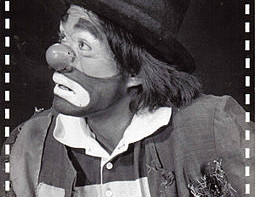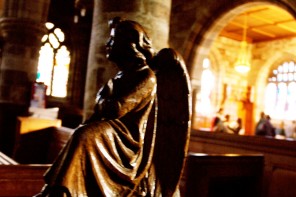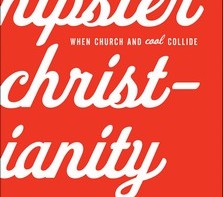‘I am not the first man who wanted to make changes in his life at 60 and I won’t be the last. It is just that others can do it with anonymity.’ — Harrison Ford
Does anonymity bring us freedom? Consider someone living in a city. While being one in a multitude can be a source of isolation and loneliness, being one in a million seems also to give us as humans the freedom to do things that we might not do where we are known. Cities seem to be home to all the weird and wonderful expressions of fashion, lifestyles, and art. When one is anonymous, the impression we make on each other seems not to mean so much, since we’re likely to never see those people again.
Now, let’s turn to art. The issue of art and anonymity is not a new subject, even here on Transpositions. Anonymity of artists has been something that is advocated by those who are concerned about the negative impact of capitalism on art and artistic practice. Nicolas Bourriaud in his book Relational Aesthetics asks whether a signature on a work of art makes the work of art a commodity, reducing it to something to be consumed rather than allowing it to be an object of participation and interaction. [1] One could extend that concern now that the celebrity culture has extended into the world of the arts with big names drawing both attention and big sums of money. Perhaps it is legitimate to be concerned in some instances as to whether the fame of the artist eclipses either our critical engagement with a work of art or our ability to appreciate it as art (rather than as an artifact of a famous person).
Anonymity of artists also manifests itself within theology, most specifically among icon artists within the Orthodox faith. Traditionally, artists who paint Orthodox icons not only work within the confines of the visual tradition of how the icons look but they also remain anonymous as the icon’s artist. The reason for this is because the icon acts as a ‘window to heaven’, as a way by which the worshipper is led through the icon and into communion with the object of prayer. While the icon is an object of great beauty and craftsmanship, it is primarily serving as an guide in worship. In this context, the potential distraction that could come with knowing the artist is eliminated by anonymity. Additionally, the artist does not paint an icon in order to make a name for themselves but does so in order to serve the worship of God.
Protestant and Catholic churches do not have the same theological convictions as Orthodoxy that necessitate anonymity of the artist. However, as these churches re-engage as patrons of the arts in a celebrity, name-driven culture, should anonymity play a role in the works of art that are commissioned for the church today? How do churches resist the desire to secure a work of art by a ‘great name’ at the neglect of creating an artful space of worship?
[1] Nicolas Bourriaud, Relational Aesthetics, English Translation, trans. Simon Pleasance and Fronza Woods (Dijon: Les Presses du réel, 2002), 93-4.




As a worship programmer/curator, I can say that anonymity has a huge impact in how creativity is received. In the space I work, work created by those we know (or have watched develop) is LESS capable of existing as pure art in the minds of the audience. Especially the performing arts. If the performer was anonymous the work would stand as Art with a capital A. Because it’s performed by a known entity (she teaches in sunday school!) we lose the ability to perceive it as anything but a hobbyist (that was nice..) Whether the art is done well or not.
I think for physical art, it would depend on the notoriety of the artist. That’s affects the “benefit of the doubt” in its reception.
I’m really intrigued by your comment and experience and wondered if I might ask a couple of follow-up questions. Firstly, I was wondering if you could expand on what you mean when you say ‘pure art’. Compared to the art you described, how does pure art operate in a worship environment? When have you seen this kind of art used effectively in worship? Secondly, I was wondering if you could elaborate on the connection you make between the artist as someone who is known within the church and the reception of the art as just a hobby, especially in reference to your latter two sentences. Were you referring to the quality of the work leading to that perception?
I agree with the first commenter that this happens the closer one gets to the artist. For example, we fawn over our kids’ productions – to affirm them, in part – but our bragging to grandparents and neighbors reveals an (often) biased and subjective perspective. The same piece performed by a stranger wouldn’t catch our attention at all.
Reflecting on your post, I have to say thanks for writing it. I’m not an artist in the traditional sense so these insights are helpful. And challenging. I write, and want to sign my name on most things. I’m not okay with simply being an anonymous window to heaven. (My delusions say I’ll become that when I’m famous and don’t need any more accolades!)
Thanks, Sam, for your comments! I’m glad that you found it helpful in your own thinking. I agree with you — I don’t think that artists should be anonymous windows to heaven (even if they are famous!). I think that if we take anonymity too far we end up losing sight of the relational and communal aspect of our lives – I don’t think that artists are intended to work as isolated, anonymous entities. Additionally, artists have been put into a communal body (the church), a place where we are to be known, loved, and supported. As I’ve thought more about the topic this week, I think that anonymity might be a helpful corrective to the goals and ambitions of an artist. Before returning to being a student, I spent 9 years in the graphic design world and understand the pressure of making a name for yourself (for both accolades and commercial viability). Perhaps there is a place for that but I wonder if a degree of anonymity – or maybe collaborative efforts that involve many in the artistic act – adjust the relationship of the artist to the worship of the church. In the church environment, it’s not about making a name for oneself but about contributing to the congregation’s worship of God.
Have you ever read Rookmaaker’s ‘Art Needs No Justification’? In it, he discusses fame in relation to anonymity. I quote at length: ‘We should not look for fame. It may be kindling the sin of pride. It may mean we lose our humility. And God may miss the praise he is owed…the meaning of work done well is in the joy of being able to have made something that was of some use to somebody…in the last resort art is anonymous. Who knows the names of the great sculptors of the Gothic cathedrals?…It is good that way. We have only added to the world God gave us to develop, to beautify. We have added to the lives of many, loving our neighbors. That should be the greatest achievement.’
What do you think about Rookmaaker’s comments?
I haven’t read the piece, Sara. Perhaps I should. I do think that looking for fame and not being anonymous are two different things, though separating them is more difficult for some than others. When I write an article I’m proud of, I enjoy attaching my name to it. This lack of anonymity is fine until I begin touting it. I might share it on Facebook. So far, so good. My heart (motive) is healthy. Then I send it to this or that friend and my conscience is suddenly pricked. I know, in that moment, that I crossed the line from sharing to bragging.
I admire the Orthodox painters, but it would kill me to keep totally silent. The balance is difficult for me.
This has been a very interesting conversation to follow, and I am most interested in the idea that knowing the artist makes it more difficult for us to appreciate his or her works of art. kjbake01 suggested that there is something called ‘pure art,’ which emerges by beings separated from our personal feelings for the artist. And Sam Van Eman offered the example of overly appreciating our children’s drawings or paintings because, as parents, our appreciation of the child’s work is biased. I’m not exactly sure what I think about this issue, but I am a little skeptical because I have found that knowing an artist encourages me to look at their work more carefully.
I do have a question for both of you, and anyone else who wants to chime in: Why should our personal feelings for the artist be irrelevant for our appreciation of the work of art? My initial reaction is that such a thing is of course irrelevant, but it might be interesting to explore why.
Thanks, Jim, for adding the conversation. I agree that a knowledge of the artist causes one to consider a work of art more carefully. Regardless of whether it leads one to consider it more or less carefully, it seems that what there is agreement about is that we engage differently with artwork of an artist who is known to us that to someone who is unknown. Because much of the visual art we engage with is by people that we do not know (ie TV, paintings, etc), I wonder if there needs to be an entirely new way of considering art appreciation in the context of ‘known’ artists. Do different criteria apply? Does it change what we consider to be good? I’m reminded of the way that Rookmaaker separates evaluation of art into the values of quality and mentality. The first refers to the skill displayed. The second is in relation to how well the artist depicts reality (and for Rookmaaker, that reality is rooted in the potential embedded in God’s creation). The second value allows a parent to praise a child’s work, not for its quality per se but for the childlike engagement with reality that might be truer to things are they really are.
Returning to the question you posed, I do think that personal feelings should be irrelevant to the appreciation of the work but I think that when some kind of personal relationship has entered the mix, that relationship has a bearing on the kind of appreciation. For example, perhaps we don’t want to hurt someone’s feelings so we don’t say what we think. Or perhaps we love someone so much that we want them to succeed we offer criticism to help them get better. I think that personal feelings are irrelevant because it doesn’t allow the art to exist separately from the relationship that generates those feelings. On the other hand, our feelings are a part of our human nature – can we turn them off in order to fully appreciate a work of art? That I’m not sure of.
What do you think?